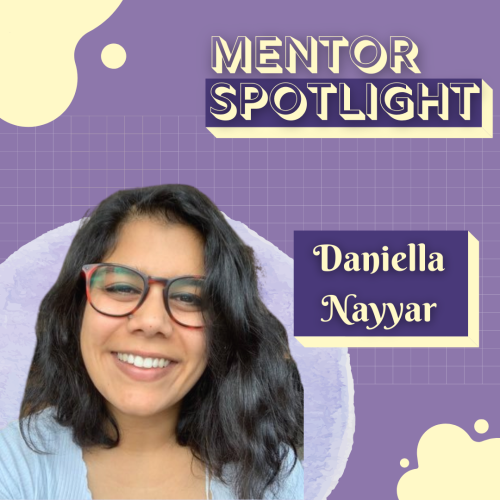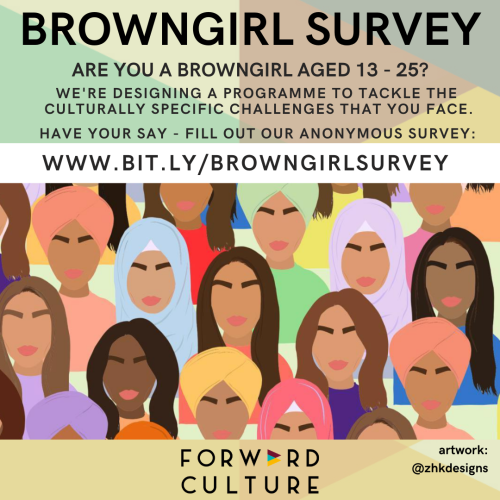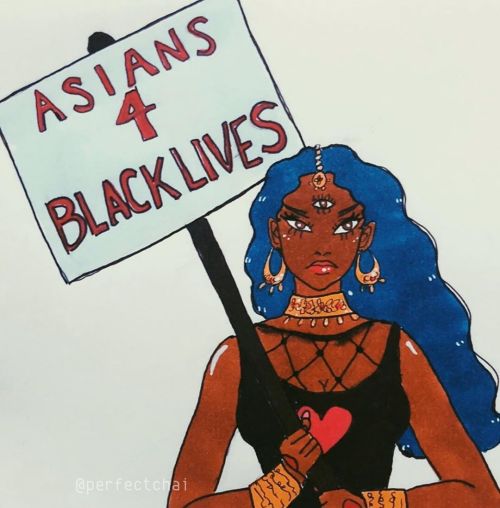TWO-BROWNGIRLS is a unique platform dedicated to the evolving identity of the artistic, intelligent and ever-curious browngirl. Follow us as we share ideas, celebrate creativity and explore what it means to be BROWN.
BROWNGIRL Mentoring Programme - Do you want a Mentor that you can relate to?
The deadline to apply is midnight on Sunday 4th April 2021!
We are connecting young women aged 16-21 from South Asian backgrounds with inspiring South Asian female mentors.
The mentoring programme will help develop your aspirations and provide a safe space to discuss challenges you’re facing such as:
- Intergenerational conflict and racism
- Lack of association or confidence in cultural identity
- Academic and career-related issues
- Sexuality, relationships and mental wellbeing concerns

We are looking for mentees who:
- Can identify 3 key areas that they would like to develop
- Can commit to regular and timely attendance to 5 sessions with your mentor over May - September 2021
- Complete any pre-meeting work set by your mentor between sessions

What you will gain
- A safe and non-judgemental space to discuss issues with a trained mentor
- Explore different solutions to overcome some of your personal challenges
- Feel heard, empowered, inspired and supported to grow and develop
How to apply
Go to our website www.forwardculture.co to read the Mentee Application Guide and complete our Application Form by midnight on Sunday 4th April 2021
South Asian Womxn and Moving out for University: A conversation between mentor and mentee
I am Daniella, a mentor for Voices of Colour, a newly created community action and digital skills programme focusing on the South Asian Womxn (SAW) Community. Voices of Colour addresses a number of problems in society, including a lack of youth voice and representation, as well as a lack of leadership opportunities for young South Asian womxn. One of the themes that has come up for many young South Asian womxn are barriers to wanting to move out of the familial home for University.
The Themes
There are a number of topics that always come up in the moving out to University conversation.
- The responsibility SAW feel for their family and their role within that unit.
- The guilt and emotions associated with the battle between your personal and collective family identities.
- The fear of an entirely new context.
- That your parents state or imply they don’t trust you out in the world or that you are not ready and how to approach these conversations.
There is a conversation I had with a mentee outlined below and a call to action for the South Asian Womxn community to band together and share our stories.
Email: hello@voicesofcolour.org
Twitter: @Voicesofcolour1
Instagram: @Voicesofcolouruk
A Conversation between mentor and mentee
I want to move out to University, but I am scared of leaving home, but I don’t want to leave my mum alone, but I don’t know if I can and I think my mum is ignoring the conversation for now.
There are a few things I want to say to this, first, if you want to move out to university whatever your reason to do so, you have every right to do that. It is your life, and you have the control and the right to make the choices for yourself. That being said, I do understand that there are many things associated with this choice. You talked about being scared of leaving home, can you expand on that?
It’s like separation anxiety, have you ever had that? Like my mum feels safe and leaving home is hard, and moving away, everything will be different and new. As a brown girl, we are not allowed to do many things and moving out would open that freedom and would be different to everything I know.
That fear you feel is of the change that is ahead of you. Whilst change is scary, it also opens so many new opportunities. It is so okay to feel scared, but also, you can use that to focus towards fighting for the things that you want for you in your life. There will be many situations that are new to you, but in the role you have played as a part of your family, whether this was something you wanted or not, you have built more resilience and self-capability than most. So, you can trust your choice and that you will be okay. You also talked about not wanting to leave your mum alone. Can you talk more about that too?
I don’t want her to feel lonely. I am always around her and I don’t want her to be by herself. She wants me to go to Uni but live at home, but I want to live life as well. I want to do what most other people my age are doing. I have the same routine now and nothing changes, if I can make my own choices, then I can make my own schedule and live like how I want to. But I don’t know how to do both.
I hear you. I think there are responsibilities that we hold as not only womxn but as South Asian womxn that make this decision weigh much more than it does or should. My advice to you is to think about why you want to move out for university, remember that all motivations are acceptable. Think about how you can remain connected to your family and your role in the family whilst at university, if that is what you want. The guilt you feel is a normal feeling considering the weight you are carrying. Mostly, I want to tell you, you are not alone in this situation and in this process. You have someone to talk to throughout this, but also there are many South Asian womxn all over the world who have had these conversations with their parents, their families, their friends or even with themselves. Reach out to people who will understand how you feel. Remember, this is your life and you have a choice in how you want to develop it and what goals you want to reach for.
Do you think having a mentor, someone to talk to, has helped at all with this?
I think mentoring has put me on a pathway to success. You have given me advice and motivation and I am going to go for it. Mentoring has helped me make a really important decision and having someone to talk to when things aren’t going your way is really good too. It helps that you are someone I can talk to that is not connected to anything in my life as well.

What next?
We know that conversations around moving out can be quite difficult for some young womxn to have with their parents. We understand that there is still a stigma attached to moving out on your own, especially for young womxn within the community. There is not one answer or approach as to how to start this conversation, but we have started this campaign to highlight how others have been able to overcome these situations and to shed a light on their journey.
If this is something that is impacting your mental health, here are some useful organisations for if you want some resources or to reach out to someone to talk to.
Resources
I shared a set of resources with my mentee in line with this chat to help her to expand her thinking on this. For those interested in the resources that do exist on this topic, I have a growing google doc page with the resources I have found so far, if you have any thoughts on these or resources to add, reach out and let us know.
If you fall into the group of South Asian Womxn and moving out to university, if it is or was a dream, became your reality, is a regret, reach out. We would love to hear from you all so we can build a support system around this experience.
A Call to Action
Our aim is to share the stories of those dealing with this now and of those who have dealt with this in the past. We want to hear your stories, the barriers, you’ve faced/face and the advice you’d provide others who are going through a similar experience. If you are planning to move out for university or want to discuss that topic, if you in the past planned to move out to university and did or did not, we want to hear from you. You can reach out to Voices of Colour directly to share your story. All you have to do is complete this quick form, which you can access here. The plan is to create visual resources to share our experiences in the community.

BROWNGIRL SURVEY: WE NEED YOU!
Following on from our work as TWO-BROWNGIRLS, we are creating a series of online workshops for all BROWNGIRLS to THRIVE. But first, we need to hear from YOU.
Please fill in the short anon survey here so that we can ensure the work we’re doing is important, impactful and relevant to YOU.
We would love it if you could share this post WIDELY!
- Aaminah & Seetal (Two-BrownGirls & co-founders of ForwardCulture)
Artwork by @zhkdesigns
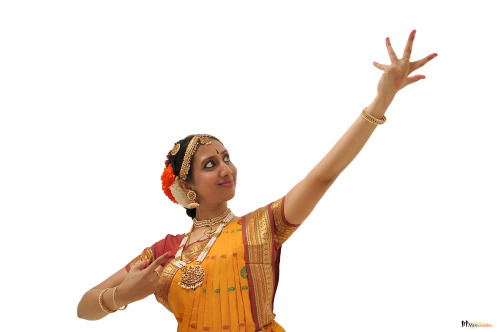

#BGROLEMODELS: MEERA VINAY - INDIANRAGA LONDON
As part of our new series platforming BrownGirl Role Models, we’re proud of introduce Meera Vinay, Director at IndianRaga London. Meera is a social entrepreneur with a penchant for fine arts. She heads IndianRaga’s operations in the UK and Europe.
IndianRaga provides a platform for aspiring artists to explore their talent, with opportunities to focus on presentation and performance, high-quality audio and video production for digital channels, and learn how to collaborate with fellow artists. It’s a great way to engage young people around the world in Indian classical music and dance.
A new project, ‘Raga Jam’ is releasing this month! It’s a specially curated series of music and dance productions, co-sponsored by Arts Council England and National Lottery.
We caught up with Meera on her career journey and what wisdom she can offer from her experiences so far…
How did you first get into performing arts?
When I was about seven or eight years, I tiptoed my way into my elder sister’s dance class.
The excitement of moving to rhythm, the energy, as well as the novelty of a new recreation- all this kindled a newfound love for dance. Eventually it developed into something more than just a hobby, rather a way of life. Music and literature were always part of conversations at home and dance snugly fit into this world. I would say the biggest support came from my family and my teachers as they helped me appreciate the significance of arts in one’s life.
What made you make the career change after 15 years working in life sciences?
There are several factors that prompted a career change. The idea was brewing in my mind for a while as I wanted to explore the possibility of becoming an independent entrepreneur. The universe dropped several hints and it was just a matter of joining the dots together. Every time, we would go travelling, the first list I would draw was that of museums or local performances. It is not to say life sciences is not a great place to be in, but my true calling was in arts. And while the passion in arts came naturally, it was a matter of making it sustainable enough for a career. A chance meeting with Sriram Emani, co-founder & CEO of IndianRaga was just the right signal to strengthen my conviction.
I found the perfect avenue to amalgamate my business acumen and lifelong fascination with arts. Serendipity is indeed an intention waiting to unfurl.
What career advice would you give to young South Asian women in the UK?
Dream BIG. Dream big and work smartly to make your dream a reality. Build resilience as you embark on your journey. Celebrate small wins as they give you the confidence to move forward however learn to take failures in your stride. Your career is akin to a marathon, it takes an enormous amount of time, a sustained effort and a small but dedicated team who want to see you succeed. The easiest thing to do as you start a career or life as an entrepreneur is finding faults in circumstances and people who stop you from achieving your goals. Stop this attitude and take control of your life without any ill will or arrogance. In the end, you will score points for being genuinely good at heart.
South Asian women are adept at managing resources and networking. I would say build on your strengths and project the leader in you so the world can see what you are capable of achieving.

What motivates or inspires you to continue your work as a performing arts producer?
As performing arts producer, I have this incredible opportunity to be the spokesperson of my rich heritage and empower others to voice theirs. I love challenges and a producer perhaps has the most complex role in the larger ecosystem of arts management. It is what makes me smile and kickstart my work with gusto every single morning.
As a performing arts producer, more so from a BAME background, one needs to think and act strategically and empathetically to ensure your stories are heard. The role of a producer cannot be emphasized more in these turbulent times when uncertainty has become the new norm.
WAITING FOR ME - MADAME GANDHI
Channeling activism, vibrancy and BROWNGIRL power, Madame Gandhi’s new track is a testament to her roots. Her music video presents jarring imagery of freedom and constraint, monotony and colour, through fashion and movement, culminating in scenes of brown women (including queer, trans and gender non-conforming) running through fields (in a non-bollywood way… we promise) and celebrating their strength and beauty. Her song is a call for us to seek power in our roots and support our community.
“This song is a global protest anthem that is about moving from the individual to the collective, from the mundane to the colorful, from oppression to liberation. And I hope it serves as a form of healing and of inspiration in these globally revolutionary times.”
Watch it here and let us know what you think!
#BLACKLIVESMATTER
It has been a just over a week since the brutal and senseless murder of George Floyd. Alongside several truths being highlighted once again, such as shameless police brutality that exists not only in the US but here in the UK too, it has become even MORE evident that our own community have a lot of work, education and unlearning to do so that so we can become strong allies and supporters of the black community. There is so much deep-rooted and frighteningly hidden racism embedded not only in our families and culture but also within ourselves. We must unlearn these behaviours and attitudes because they are costing black people their dignity, humanity and their LIVES. It’s important to remember that although educating our families, communities and unlearning is crucial and will lead to change, we must also take action by donating, signing, writing to our MPs and ultimately, agitating the system that has allowed black lives to be killed and their killers to walk free. Here are some links to signpost you toward engaging with and supporting the #BLACKLIVESMATTER movement. Some are educational resources, and others are links to donate to help the family of George Floyd and relevant organisations.
DONATE:
(1) Contribute toward funeral costs and support the family of George Floyd
(2) Donate toward the Ahmaud Arbery fund, a 25 year old boy who was chased and shot senselessly this February.
(3) Support the #BLACKLIVESMATTER movement.
EDUCATE:
(1) READ: a comprehensive folder compiled by Suhaiymah Manzoor-Khan including many resources on unlearning anti-blackness in South Asian communities. Also, follow @Southasians4blacklives on Instagram to view and share important infographics.
(2) Check out this list of children’s books with focusing on supporting conversations around race, resistance and prejudice.
(3) A compendious guide filled with links and PDFs to educate you from a guide on how to discuss anti-blackness at home, to articles about racial justice, the myth of reverse racism and many more.
CHANGE:
(1) Sign this petition to get ALL of the officers involved in the senseless murder of George Floyd charged.
(2) A brilliant thread on how to be an ALLY. Share with your communities so we can change ourselves and our communities:
(3) Sign the petition to DEFUND the police.
————
There are also many important links, petitions and funds we can all collectively support, and this is by no means a complete list. Please do share below any petitions, websites, funds, social media accounts and resources that we can all use, too.
Rest in peace George Floyd, and the hundreds of thousands of people brutally murdered as a result of racial injustice. If we all work together, change is on the horizon.
(Pic c/o @perfectchai on instagram)
NEVER HAVE I EVER - NETFLIX SERIES - TWO-BROWNGIRLS THINKS
If you’ve not seen ‘Never Have I Ever’ on Netflix yet, you’ve either been perfecting a new, obscure, artistic hobby or living under your duvet for the past two months of quarantine. Both of which are perfectly acceptable by the way, #selfcarefirst. But this new show has been causing quite a stir in the BROWNGIRL community and beyond that too. Yes, that’s right, white people have watched a 10-part, teen comedy/drama series with a young American Indian girl as the protagonist. It’s been number 1 on Netflix around the world, which is a pretty big deal. That’s why we thought we should write about it. Here are our thoughts…
1. They tried
From our brief but adequately thorough research on the making of ‘Never Have I Ever’, it’s clear that Mindy Kaling’s intentions were good. First of all, the whole idea for the series came about when Netflix approached Mindy Kaling and asked if she would create a show about her childhood. This perspective may explain a lot of the seemingly awkward encounters that Devi (the main character) has with Indian/Hindu culture. As Mindy explains in a telling interview with NY Times,
“There was a comment on Twitter saying, “Oh, great that is totally not how Hindu girls talk.” And I remember being incensed because when my mom used to make us pray before we took the SATs, or before we got on a plane, and I didn’t know all the different names of the gods because no one had taught me.”

Although we’d love Devi to embrace her culture (duh, that’s what Two-BrownGirls is all about!), we accept that it is a journey and a process that’s different for everyone. The moment when she meets a brown guy at Ganesh Puja who explains that only when he went away from home for college did he actually realise that his heritage made him unique, resonated a lot with us. Maybe making this series is a part of Mindy Kaling’s own journey to understanding her identity too?
2. Representation, Relatability and Responsibility
As the conversation around representation on mainstream media continues to simmer, our understanding of artistic freedom has to be incorporated too. The creators of the series were trying to follow an American teen comedy/drama template while pushing the needle on diversity - not an easy task. Think, Mean Girls meets Bend it Like Beckham, you’d think it could go either one of two ways. That’s why ‘Never Have I Ever’ has some teething problems that we think we all (creators included) need to settle into. For example, going too hard on the ‘sex-thirsty’ narrative jarred with us (Devi hadn’t even kissed anyone yet!). Handling Hindu narratives within the context of the Indian political climate and briefly incorporating a character who was ostracised by her whole community for marrying a Muslim are areas that writers of a show this mainstream need to take more responsibility for.

3. Stereotypes much?
Ok, we need to talk about the accents. We thought it was just us but quickly realised that most other people had been finding Kamala’s and Devi’s mum’s grating and their characters two-dimensional. I mean, even Mallika Dua posted her frustration on Instagram stating that ‘no one from India talks like Apu Nahasapeemapetilon’. We honestly thought that some aspects of Kamala’s character, particularly her aloof-ness, were quite insulting to people from India. Man, talk about widening the NRI divide.
There’s been a lot of controversy around diasporic portrayals of Indian elders, particularly when it comes to Lilly Singh’s ‘parent’ characters which dehumanise their experience. This is a careful line that comedy treads. Often it’s most effectively executed when the stereotypes are used to make a social or political statement or change a point of view such as in a number of Goodness, Gracious Me’s sketches. ‘Never Have I Ever’ was trying to lean this way but the character portrayals and accents need more fleshing-out and nuance.
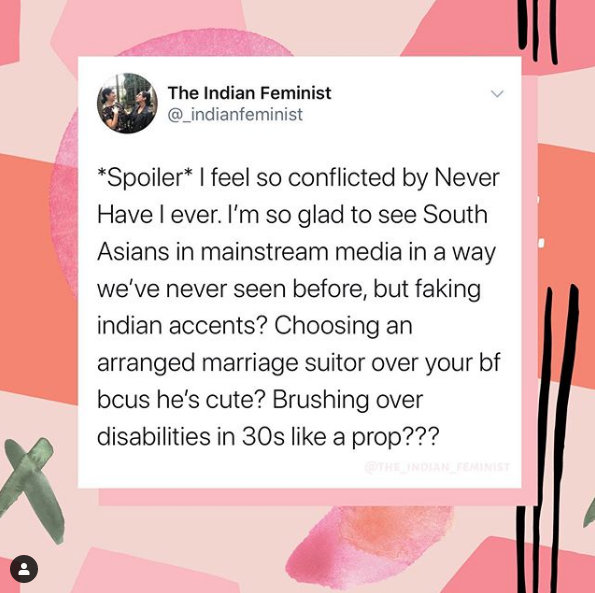
4. Hopes
There’s no news of a season two yet but the series does end on quite a cliff-hanger that leaves a lot of people wanting more! With all the media coverage and heated debates in the brown diaspora, it’s clear that there is an appetite for the show to carry on. It’s great to see mainstream representation and if there is a second season, it would be awesome to see Kaling explore South Asian identity in a more complex and nuanced way. We also hope that there’s room for an interesting non-white love interest, that Devi and her mum work it out and that Kamala moves out!
The creative team behind the show are well aware of their responsibility with how much of a step forward this is for diversity and we find Maitreyi so endearing that it’s hard to be too harsh.
We hope that Mindy Kaling takes on board the feedback from her target audience and uses it to inform some of her decisions moving forward. In her own words, “Those people who watch the show, particularly young Indian-American women, are the people that I want to like it the most. And they’re the ones that are going to be the toughest on me. So it’s one of the biggest things I care about now as an artist.”

THE BENEFITS OF MY MULTICULTURAL IDENTITY
What does it mean to be multicultural? How do we experience the world through the lens of our accumulated cultural baggage? As more layers get added to this baggage, does it get harder to find ourselves within it all?
In our third and final feature with exceptional Kathak dancer Sonia Chandaria Tillu, Sonia explores the positive aspects to growing up with multiple heritages. In her new show, ‘Breaking Ground’ she traces her grandmother’s move from her homeland of Gujarat to the fertile lands of Kenya, and culminates with Sonia’s own journey to the UK.
Here are Sonia’s 3 benefits to having a multicultural identity:
(1) Empathy - I’m able to easily understand and connect with people from different cultures. Growing up with multiple perspectives, languages and ideas really widens my worldview.
(2) It’s a great excuse! - When I don’t understand something, for example a reference from British culture, I blame it other aspects of my identity. Not all of us watched CBBC growing up!
(3) I can pick the best from all cultures - Growing into adulthood, I can now take the best of all 3 country’s into my life… Indian food, British organisation skills, a Kenyan sense of humour!
Sonia’s been working super hard to develop her solo work so support and share the news of her new show in Birmingham tomorrow! All details HERE.






STORIES FOR SOUTH ASIAN SUPER GIRLS
When we first saw the social media buzz a while back about this revolutionary new book by Raj Kaur Khalsa, we were so excited to get our hands on it and see it for ourselves.
All of the blogs, apps and online content to inspire young girls is great but there’s nothing quite like holding a beautifully designed book in your hands and taking the time to turn the pages.
We loved the diversity of stories, the colourful, unique illustrations and the best part was the section where a little girl could draw herself and her story too!
Can’t wait to gift this to our nieces and little cousins when they old enough! Check out more about the brilliant publication HERE
BREAKING OUT OF THE BOX - SONIA CHANDARIA TILLU
For every #BROWNGIRL, redefining, rejecting and creating new ‘labels’ that society gives us or we choose to identify with has a huge impact on our lives, ideas and ambitions. One of the reasons we started TWO-BROWNGIRLS was because we wanted to connect with other women who were defining their identity for themselves and could be inspirations and role models for others. In the second part of our three-part series highlighting emerging dance artist, Sonia Chandaria Tillu, Sonia shares with us how she has constantly worked and lived to break out of conventional labels placed upon her.“Am I an accountant or a dancer? Indian, Kenyan or British? Professional, semi-professional, amateur? Classical, semi-classical or a commercial dancer? Do I aspire to be a career woman or housewife? Even my dating status apparently needed to fit into a category…”
 When Sonia set up her own company, Sona Lisa Dance, she decided to make it part of the artistic mission to challenge these labels society puts on us.
When Sonia set up her own company, Sona Lisa Dance, she decided to make it part of the artistic mission to challenge these labels society puts on us. “In my piece ‘Breaking Ground’, I explore multicultural identity and the impact of migration. How do we unpack the emotional conflicts that arise from sometimes multiple migrations? Every time we move to a new country we experience it through the lens of our cultural baggage.”Check out the video HERE that shares her creation process and introduces some of the artistic team.
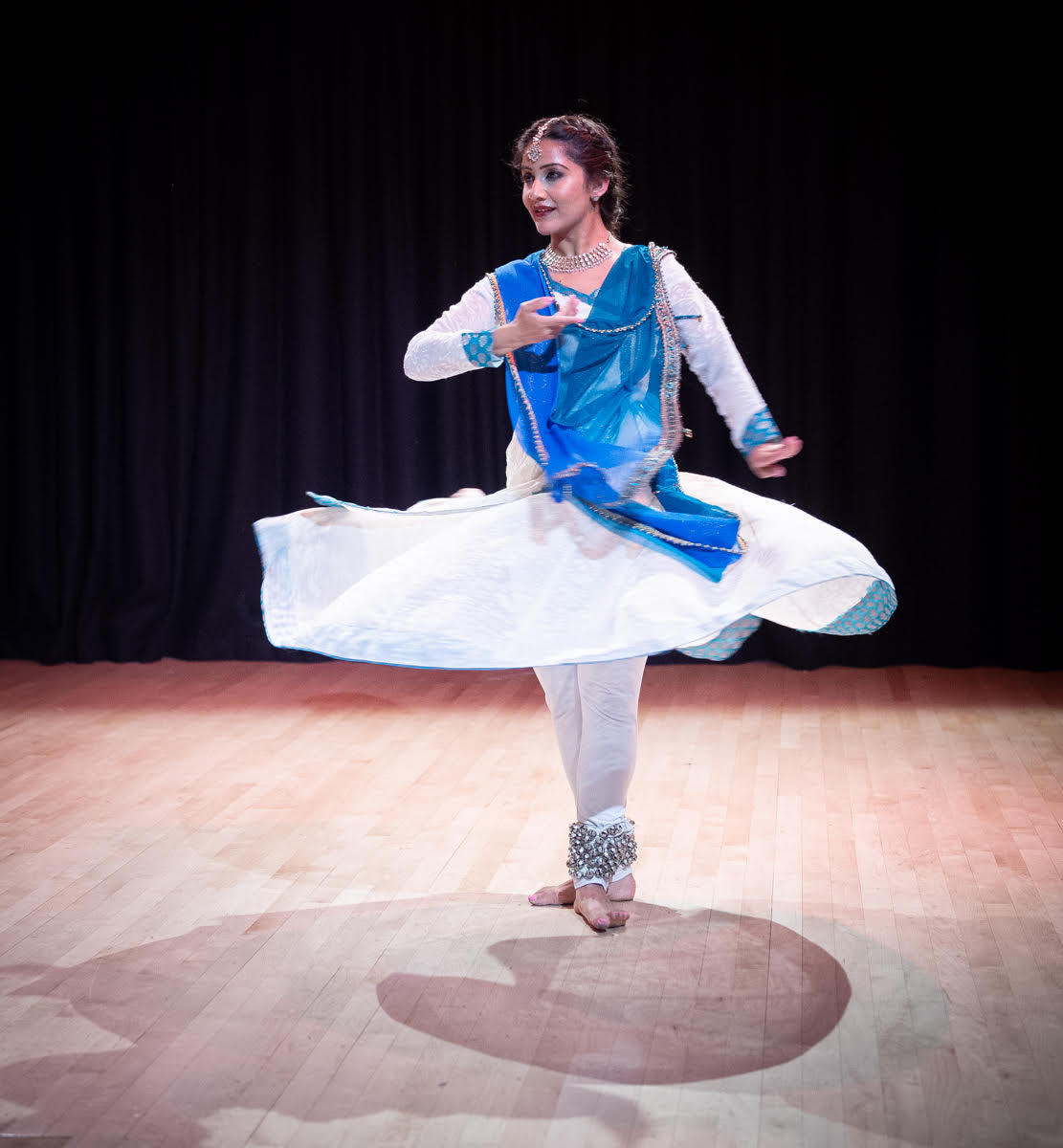 Sonia is also inspired by women who have come before her such as Indian freedom fighter, Aruna Asaf Ali. In her new piece ‘Āgraha’, choreographed by Jose Agudo, Sonia explores how Aruna played an active role in Gandhi’s Satyagraha Salt March. “On one level she was a really compassionate, empathetic and caring woman and on the other hand she was an extremely radical and independent thinker - it’s amazing to read her biography to attempt to understand how she drew on these various aspects of her personality in a totally organic way. More about this piece is on our website HERE.”
Sonia is also inspired by women who have come before her such as Indian freedom fighter, Aruna Asaf Ali. In her new piece ‘Āgraha’, choreographed by Jose Agudo, Sonia explores how Aruna played an active role in Gandhi’s Satyagraha Salt March. “On one level she was a really compassionate, empathetic and caring woman and on the other hand she was an extremely radical and independent thinker - it’s amazing to read her biography to attempt to understand how she drew on these various aspects of her personality in a totally organic way. More about this piece is on our website HERE.” Catch Sonia performing these new works at the MAC Birmingham on 30th November 2019. Tickets and more info HERE.
Catch Sonia performing these new works at the MAC Birmingham on 30th November 2019. Tickets and more info HERE. It’s so important to continually share stories of women that are breaking the boundaries of the boxes that they’ve been placed into so that more people, especially of the next generation, can see what’s possible. We can choose what labels we are defined by and create new ones too so that before you know it, there are no more boxes that fit us at all.
IS RAKSHA BANDHAN FOR SISTERHOOD?
Earlier this week I was catching up with one of my Bhabis (sister in laws) who has recently had a baby. Just as we were leaving the restaurant she mentioned how she needed to pick up a gift for her older daughter to give to her younger daughter for ‘rakhri’ (Raksha Bandhan). It dawned on me in that moment how revolutionary but also how obvious her thinking was.
“A man’s tie with his sister is accounted very close. The two have grown up together, at an age when there is no distinction made between the sexes. And later, when the sister marries, the brother is seen as her main protector, for when her father has died to whom else can she turn if there is trouble in her conjugal household.
The parental home, and after the parents’ death the brother’s home, often offers the only possibility of temporary or longer-term support in case of divorce, desertion, and even widowhood, especially for a woman without adult sons. Her dependence on this support is directly related to economic and social vulnerability.”
— Bina Agarwal in A Field of One’s Own: Gender and Land Rights in South Asia (1994), quoting Adrian C. Mayer, Caste and kinship in Central India (1960)
I’ve grown up with an older brother and male cousins who I would tie a ‘rakhri’ (thread) on every year and yes, look forward to presents/money from! The tradition comes from the brothers of a family protecting, caring for and looking after their sisters (and more recently, a convenient way to ‘friend zone’ guys!).
But as girls, do we still need ‘protecting’? My bhabi explained how she had made a rule for younger siblings to tie rakhri on their older siblings, regardless of their gender. I thought it was a pretty neat idea but also immediately thought about how many more patriarchal traditions we have to reinvent or perhaps scrap as new generations evolve.
Just like the pink ladoo when a girl child is born or our mothers ‘giving us away’ on our wedding, are we taking patriarchal traditions as a standard and trying to mould ourselves into them or are we truly making a feminist statement and changing the status quo?
BREAKING GROUND - SONA LISA DANCE COMPANY
Why is it so important for us to understand each others stories?
In this social and political climate rife with xenophobia, it’s more important now than ever for us to look past our judgments and perceptions (particularly those perpetuated by the mainstream media) and see each other for who we really are. Sharing our stories through dance, music and art is one of the most visceral ways to do this.
“The act of migration puts into crisis everything about the migrating individual or group, everything about identity and selfhood and culture and belief.” ~ Salman Rushdie
Award-winning Kathak dancer, Sonia Chandaria Tillu is creating an emotive new dance piece inspired by her family’s migration story. Tracing her grandmother’s move from her motherland Gujarat (India) to the fertile lands of Kenya in the 1940s, ‘Breaking Ground’ culminates with Sonia’s own journey to the UK decades later.
“Many of us, especially younger generations, consider aspects of our cultural identity as baggage. Through my piece, I want to unpack this idea to see how the so-called cultural baggage can be valued as heritage instead.”
Using innovative Kathak dance, metaphorical poetry and a specially commissioned music score, the show unpacks the highly-relevant emotional conflicts that arise from multicultural identity. It explores how we experience the world through the lens of our personal, accumulated “cultural baggage”. As more layers get added to this baggage, does it get harder to find ourselves within it all?
Check out her work on her website, Facebook and Instagram!
Sonia will be sharing her work on ‘Breaking Ground’ so far at Attenborough Arts Centre in Leicester on Friday 23 August 2019.
> BOOK TICKETS HERE <
All details in the flyer below…
[photo credit: Simon Richardson]

A STORY FOR OURSELVES, THIS TIME - SUHAIYMAH MANZOOR-KHAN
An original poem, written and performed by Suhaiymah Manzoor-Khan (@thebrownhijabi - www.thebrownhijabi.com)
When we met Suhaiymah at our event in collaboration with South Asian Sisters Speak #WHOWEARE in April 2018, she recited this poem to us and we instantly knew that we had to create something with her so that more people could hear and feel its message.
Fast forward to summer 2018 and we worked with Suhaiymah to conceptualise this short film capturing the poem in the best way we could with whatever means we had. We decided to film in Leeds, where Suhaiymah was born and raised and in two contrasting local locations that represent the immigrant experience in confinement and liberation.
This is part of our mission with ForwardCulture (www.forwardculture.co) to promote South Asian female artists in their own right and as inspirational role models for the next generation.
The poem speaks of BROWNGIRLS and how we struggle with stereotypes and opinions placed upon us but by searching within and finding ways to authentically evolve and continually redefine who we are, we can find power and freedom.
Not Today’s Yesterday - Seeta Patel

Seeta Patel is a force to be reckoned with. Her strong will, magnetic presence and passionate ideas come across equally as powerful on and off stage. But the life of a dance artist isn’t as glamorous as it may seem. Seeta is extremely busy with multiple projects on the go at once but I manage to catch her during a brief lunch break while rehearsing with a group of rising Bharatanatyam dancers in Birmingham as part of #TheNatyaProject, to chat about her exciting new tour.
Not Today’s Yesterday is an international collaboration between UK award-winning Bharatanatyam artist Seeta Patel and Australian choreographer Lina Limosani. This work blends classical Indian dance (Bharatanatyam) & contemporary dance in a striking, intelligent and engaging evisceration of ‘pretty’ and ‘suitable’ historical stories. It is a one-woman show which subversively co-opts whitewashing against itself.
“The inspiration stems from our concerns that revisionist and airbrushed histories have become a central issue of tension throughout the world, in particular in Western democracies.”

I first asked Seeta how the idea of the work came about as I was aware that it had been a number of years in progress.
“It started with my feeling that the history of Bharatnatyam has been white-washed. Having read Unfinished Gestures by Davesh Soneji, it really blew my mind that many of us going through the system are not often taught about the social and political history of the art form in its entirety. There’s more niceness rather than the grit of it. This is basically how history is white-washed in order to make it more palatable.”
I’d seen the work in progress around a year ago and it was haunting, hypnotic and extremely clever in its execution. Through the medium of a fairy-tale story, it draws people in with eerie familiarity, but as with any fairy-tale there are always dark undertones. Parts are grotesque and exaggerated with caricatures of colonial supremacy but other parts are gentle and vulnerable as Seeta gazes wide-eyed into the depths of what was.
The collaboration between Seeta and choreographer, Lina Limosani was first funded by the Arts Council’s Artist International Development Fund 2016 where Seeta travelled to Australia where Lina is based, to research and develop the work.
“Britain and Australia, amongst others, have sordid histories and relationships with indigenous and migrant communities. Skewed histories fuel a distorted sense of nationalism. This work aims to open up conversation through a clever appropriation of whitewashed histories.”

The following year, Seeta was able to gain further funding to develop the work in Poland, as another one of the collaborators was based there and perform previews of ‘Not Today’s Yesterday’ around the UK. Being based in a foreign country during this process really fuelled the creative ideas and themes, which fed into the piece.
Earlier this year they were able to sharpen the work to a fine point and received funding to perform ‘Not Today’s Yesterday’ at Adelaide Fringe Festival. During that period, they were successful in gaining a UK touring grant for this Autumn, so it has been through several stages and Seeta envisions it to live on in many different contexts, as the work deals with some of the most pressing issues of our time.
“This piece is a part of my wider work. Along with my classical work, whatever I do is political on a certain level. I can’t wake up in the morning and change the colour of my skin or the country that I’m born and live in, I am political. It’s not something I can choose to remove. I’m not of that privilege. Not in this country.”
As Seeta’s career rises and expands, I’m interested to learn about what advice she has to offer the next generation who look up to her as a role model and as an example of someone with a successful career as an Indian classical dancer or dancer from a South Asian background in this country. She’s brutally honest and explains that this career is by no means conventional, in any sense of the word. Her path has forced her to challenge the accepted ‘norms’ that we are socialised into as first and second generation South Asian immigrants who constantly strive to over-achieve. So to have to find temporary or casual work through the ebbs and flows is perfectly acceptable as it means that you can earn money, which doesn’t have to eat into the time that you want to work on dance.
“Certain professions require just as much energy as dance does, so I don’t personally believe that you can do both and give each job the commitment that it deserves.” says Seeta. “You have to understand what you really want and sometimes take scary steps to get there that you’re not confident or comfortable with.”
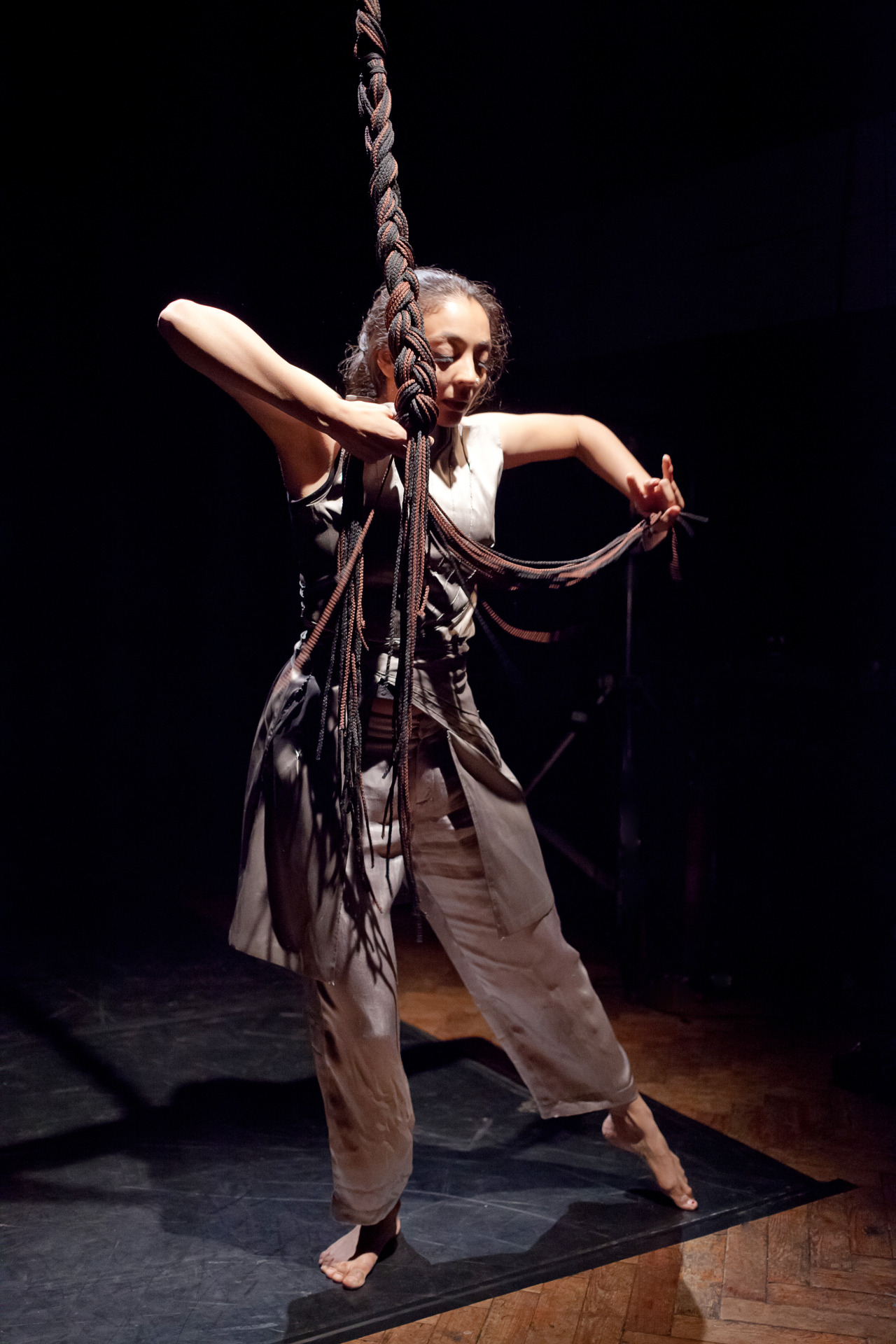
The interactive element of the work is the carefully curated post-show talks, as Seeta hopes that the audience becomes lured into a dark fantasy and taken on an experiential journey during the performance then the discussion afterwards is a chance for reflection and transformation.
Each performance has specifically relevant researchers, academics and powerful personalities who will help to uncover the themes behind the performance and welcome the audience to share their thoughts and ideas too.
So don’t miss out on a very special chance to experience a dance theatre work by such a phenomenal BROWNGIRL and book your tickets to a performance near you.
TOUR DATES
Seeta is on a UK Tour of her one woman dance theatre work Not Today’s Yesterday this Autumn 2018. A collaboration with Limosani Projects. Tour details as follow:
- 2nd Oct - The Place
- 3rd Oct - The Place
+44 (0)20 7121 1100
SPEAKERS
2nd October
Gurminder K Bhambra is Professor of Postcolonial and Decolonial Studies in the School of Global Studies, University of Sussex.
Alice A. Procter is an art historian and museum educator. She runs
Uncomfortable Art Tours, unofficial guided tours exploring how the UK’s major art institutions came into being against a backdrop of imperialism.
Tanika Gupta - Over the past 20 years Tanika has written over 20 stage plays
that have been produced in major theatres across the UK. She has written 30
radio plays for the BBC and several original television dramas, as well as scripts
for EastEnders, Grange Hill and The Bill.
3rd October
Kenneth Tharp - Kenneth Tharp is the former Chief Executive of The Place, the
UK’s premier centre for contemporary dance.
Inua Elams - Born in Nigeria, Inua Ellams is a cross art form practitioner, a poet,
playwright & performer, graphic artist & designer and founder of the Midnight Run — an international, arts-filled, night-time, playful, urban, walking experience.
Tobi Kyeremateng - Tobi Kyeremateng is a theatre, festival and live
performance producer. She is currently Producer at Apples and Snakes,
Executive Producer (Up Next) at Bush Theatre, and Programme Coordinator at
Brainchild Festival.
- 5th Oct - Amata Theatre Falmouth University
Phone: 01326 259349
Email:
SPEAKERS - TBC
- 12th Oct - Watermans Arts Centre
Box Office: 020 8232 1010
SPEAKERS
Bidisha Mamata: Bidisha is a British writer, film-maker and broadcaster/presenter for BBC TV and radio, Channel 4 news and Sky News and is a trustee of the Booker Prize Foundation, looking after the UK’s most prestigious prizes for literature in English and in translation.
- 13th Oct - Kala Sangam, Bradford
SPEAKERS
Pauline Mayers Associate Artist with the West Yorkshire Playhouse Pauline produces her own shows as The Mayers Ensemble themed around participation, intimacy and identity.
Suhaiymah Manzoor-Khan is a writer, speaker,
playwright, award-winning spoken-word activist and founder of the political blog www.thebrownhijabi.com
- 23rd Oct - Patrick Centre, Birmingham
Box Office: 0844 338 5000
SPEAKERS
Dr Kehinde Andrews: is Associate Professor of Sociology, and has been leading
the development of the Black Studies Degree at Birmingham City University.
Abeera Kamran: is a visual designer and a web-developer based in Birmingham
and Karachi, Pakistan. Her creative practice is research-based and lies at the
intersections of design, archiving practices and the internet.

“Once upon a time… in a faraway land… it happened… did not happen… could have happened.”
Supported by Chats Palace, Arts Council England, Country Arts SA, Arts SA, The Place London, Adelaide Fringe Artists Fund, LWD Dance Hub, British Council, The Bench UK and NA POMORSKIEJ Artist residency.

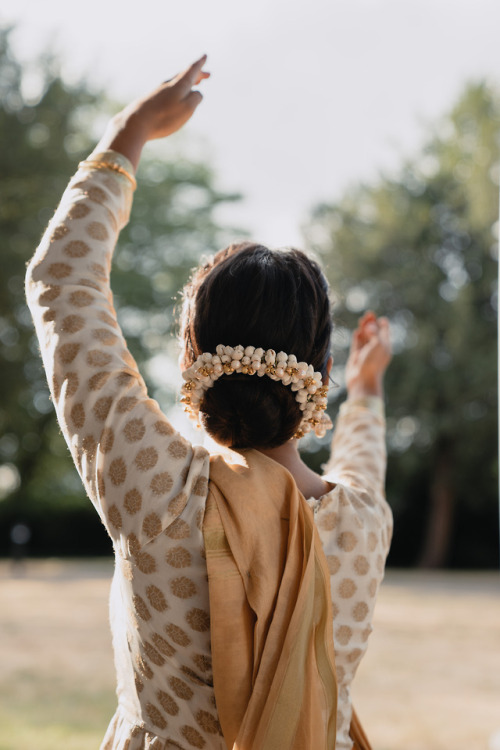

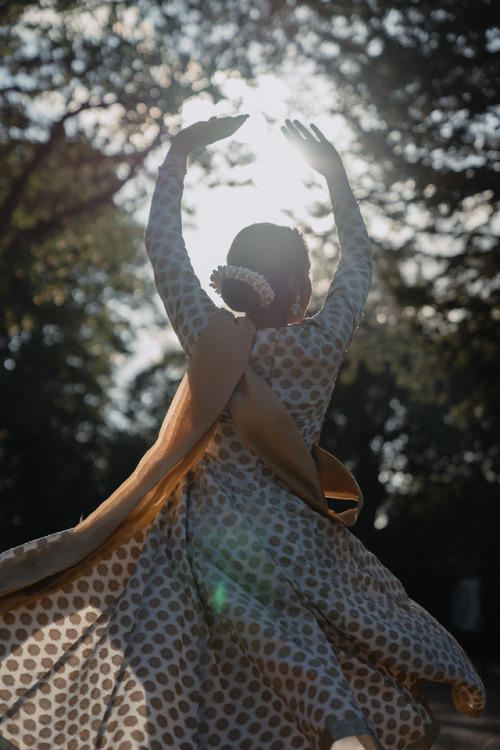






What is ‘Kathak’? - The Photo Series
I’ve been studying Indian classical dance for about 10 years now but it’s something that I’ve not really shared openly within the whole 'BROWNGIRL’ community.
The first half of my journey was in Bharatanatyam (South Indian Classical Dance) and Hindustani Vocal music and the second half continues with Kathak so I’ve not really been practicing that long.
But I’ve fallen deeply in love with it and plan to improve for the rest of my life. So here’s my little series on what I’ve learned about the various elements of Kathak so far and with the help of the brilliant photographer Jahied Ahmed, I only hope to share the love and joy of this wonderful art form with as many people as possible.
HISTORY - COSTUME
Every art form has a socio-economic history and Kathak certainly had a bumpy ride. The current form is pretty recent but it originated in the courts and temples of Northern India. As 'Kathakaar’s or story-tellers travelled and performed they absorbed local influences so there is one costume that is a skirt and blouse with dupatta (scarf) and one that has more Persian influences from the Mughal courts known as an 'anarkali’ or 'angarkha’ dress costume. The jewellery, flowers and makeup are all suited to evoke a sense of regal, dignified and special presence.
MOVEMENTS AND SPINS - SPEED AND GRACE
When most people see Kathak, perhaps for the first time, they’re most likely to notice the fast turns that the dancer will execute known as 'chakkars’. Now, this is where things can turn into a bit of a circus, I believe. Yes, like ballet, Kathak’s spins take years of focus, practice and falling(!) to pull off effectively. They are beautiful and impressive, but that’s not all that Kathak is about. Notice the details in the wrists, the flow of the fingers and the bend, twist and sway of the torso. Kathak training goes into minute command of the minor limbs, elements of posture, alignment and tension that take care and attention. They’re also so idiosyncratic so that the same movement can look different on everyone!
RHYTHM - GHUNGROO AND FOOTWORK
Rather than getting technical, let’s get universal. We all have a beating heart and can feel the drive and pulse of rhythm, and that’s what Kathak plays with so cleverly. I always say that I feel like Kathak is music in motion. It is so tied to the melody, poetry and 'taal’ or time cycle that it just brings it all to life. Just like tap dance or flamenco, Kathak uses complex footwork patterns to create mathematical patterns and groovy beats. But we can’t go crazy! We’ve got to keep balance and poise and always be accutely aware of the time cycle so that we can fit our pattern accurately within it.
EXPRESSION, GESTURE AND STORY-TELLING
Perhaps the most deep and profound aspect of Kathak and Indian Classical Dance in general is 'Abhinaya’ meaning, 'to lead towards’. Here the dancer depicts a story, emotion or character and draws the audience into their world. Tapping into human empathy and emotion, the dancer emotes and projects a sentiment and if they are strong and effective enough, the audience will feel and see what the dancer sees too.
I hope you enjoyed reading as much as I did writing and working with Jahied, please do check out his work!

